
Trams are a major form of public transport in Melbourne, the capital city of the state of Victoria, Australia. As of May 2017, the Melbourne tramway network consists of 250 kilometres of double track, 493 trams, 24 routes, and 1,763 tram stops. The system is the largest operational urban tram network in the world. Trams are the second most used form of public transport in overall boardings in Melbourne after the commuter railway network, with a total of 206 million passenger trips in 2017–18.

Yarra Trams is the trading name of the operator of the tram network in Melbourne, Australia, which is owned by VicTrack and leased to Yarra Trams by the Victorian Department of Transport. The current franchise is operated by Keolis Downer. As at May 2014, Yarra Trams operate 487 trams, across 26 tram routes and a free City Circle tourist tram, over 1,763 tram stops. With 250 km (155.3 mi) of double track, Melbourne's tram network is the largest in the world.
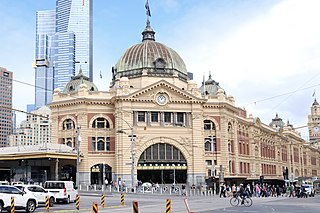
The Melbourne rail network is a passenger and freight train system in the city of Melbourne, Victoria, Australia. The metropolitan passenger rail network is centred on the Melbourne CBD and consists of 222 stations across 16 lines, which served a ridership of 99.5 million over the year 2021-2022. It is the core of the larger Victorian railway network, with links to both intrastate and interstate systems.

Connex Melbourne was a train operator in Melbourne, Australia. Formed in July 1998 as Hillside Trains, a business unit of the Public Transport Corporation, it was privatised in August 1999 becoming a subsidiary of Connex.
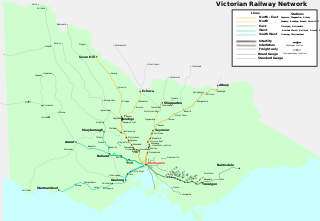
Rail transport in the Australian state of Victoria is provided by a number of railway operators who operate over the government-owned railway lines. The network consists of 2,357 km of Victorian broad gauge lines, and 1,912 km of standard gauge freight and interstate lines; the latter increasing with gauge conversion of the former. Historically, a few experimental 762 mm gauge lines were built, along with various private logging, mining and industrial railways. The rail network radiates from the state capital, Melbourne, with main interstate links to Sydney and to Adelaide, as well as major lines running to regional centres, upgraded as part of the Regional Fast Rail project.
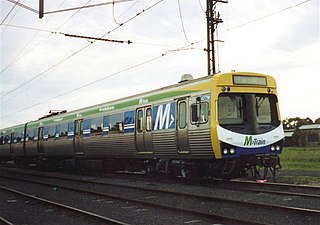
M>Train was a train operator in Melbourne, Australia, and operated some of the city's suburban rail operations. Formed in July 1998 as Bayside Trains, a business unit of the Public Transport Corporation, it was privatised in August 1999 becoming a subsidiary of National Express.
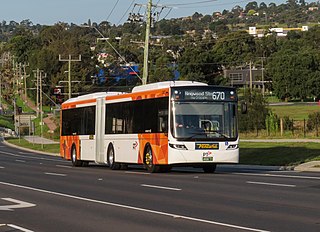
Buses in Melbourne, Australia, are a major form of public transport in Melbourne, with an extensive bus network. There are 346 routes in operation with a varying range of service frequencies, operated by privately owned bus companies under franchise from the State Government. The Night Network bus system consists of 10 routes and operates on Friday and Saturday nights, and a SmartBus orbital bus network currently consisting of nine routes, which is intended to facilitate cross city travel, while the current network is predominantly a radial network. Most of the bus network is a covered by the myki ticketing system.
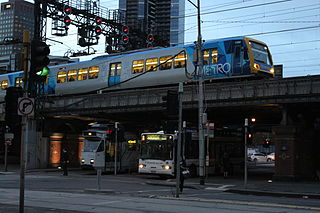
Transport in Melbourne, the state capital of Victoria, Australia, consists of several interlinking modes. Melbourne is a hub for intercity, intracity and regional travel. Road-based transport accounts for most trips across many parts of the city, facilitated by Australia's largest freeway network. Public transport, including the world's largest tram network, trains and buses, also forms a key part of the transport system. Other dominant modes include walking, cycling and commercial-passenger vehicle services such as taxis.
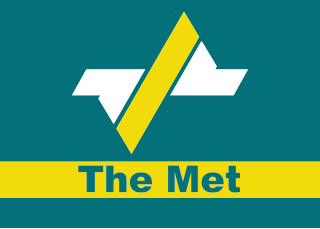
The Public Transport Corporation (PTC) was a Victoria State Government owned statutory authority formed under the Transport Act 1983 which operated passenger and freight trains, trams and bus services.

The Geelong Transit System (GTS) was the operating brand of public transport in Geelong, Victoria, Australia. It was a joint venture between the Kefford Corporation's Benders Busways, and McHarry's Buslines. From 2009, timetables and signage were branded as Geelong Transit with a standard Viclink orange theme, so it is unclear to what extent the former GTS entity still exists as such. Since 2009, GTS ticketing has become part of the statewide myki smartcard system.
Transport law is the area of law dealing with transport. The laws can apply very broadly at a transport system level or more narrowly to transport things or activities within that system such as vehicles, things and behaviours. Transport law is generally found in two main areas:
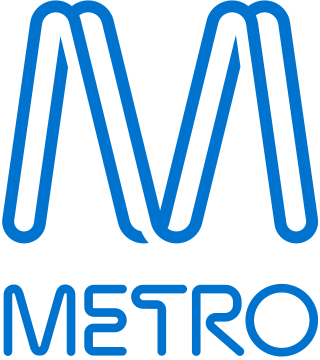
Metro Trains Melbourne, often known simply as Metro, is the operator of services on the electrified suburban passenger rail network in Melbourne, Victoria, Australia. Metro Melbourne is the largest suburban rail network in Australia with 17 lines, 219 stations and 405 km (252 mi) of railways and second busiest network in Australia. It is owned by Public Transport Victoria who sublet the infrastructure and rolling stock of Metro Trains Melbourne to a joint venture between Hong Kong-based MTR Corporation (60%), John Holland Group (20%) and UGL Rail (20%). The three constituent companies are also partners in the Metro Trains Sydney joint venture, which has operated the Sydney Metro network since 2019.

The Transport Integration Act 2010 is a law enacted by the Parliament of the State of Victoria, Australia. The Act is the prime transport statute in Victoria, having replaced major parts of the Transport Act 1983, which was renamed as the Transport Act 1983.

The Rail Safety Act 2006 is a law enacted by the Parliament of the State of Victoria, Australia, and is the prime statute regulating the safety of rail operations in Victoria. The Act was developed as part of the Transport Legislation Review conducted by the Department of Transport between 2004 and 2010 and is aimed at preventing deaths and injuries arising from rail operations.

The Director of Public Transport was the head of the Public Transport Division (PTD) of the Victorian Department of Transport. PTD was the government agency responsible for promoting, providing, coordinating and regulating public transport in the state of Victoria, Australia between August 1999 and June 2013. The Director of Public Transport was created as a statutory office supported by staff of the Department of Transport.
The Director, Transport Safety, who operates as Transport Safety Victoria, is the independent Government agency responsible for bus and marine safety in the State of Victoria, Australia. The position was created as a statutory office by the Transport Integration Act 2010 and the office commenced operation on 1 July 2010. The Rail branch of TSV completed transfer to the Office of the National Rail Safety Regulator (ONRSR) in December 2019.
The Chief Investigator, Transport Safety is the independent Government agency responsible for investigation of safety-related trends and incidents in the rail, bus and marine industries in the State of Victoria, Australia.
Public Transport Victoria (PTV) is the brand name for public transport in the Australian state of Victoria. It was the trading name of the Public Transport Development Authority (PTDA), a now-defunct statutory authority in Victoria, responsible for providing, coordinating, and promoting public transport.
The Transport Act 1983 was the main statute establishing government transport organisations and regulating land transport activities in the State of Victoria, Australia for 27 years from mid-1983 to mid-2010. The Act was used as the vehicle for changes to transport organisational arrangements and transport regulation activities pursued by Victorian governments over that period.

The Transport Act 1983 is a prime statute regulating transport activities in the State of Victoria, Australia. Key areas regulated by the statute currently include taxi and hire car services and compliance and enforcement, particularly in areas like safety and public transport ticketing and conduct.
















